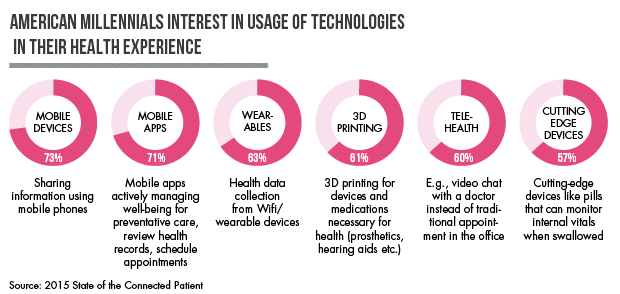![]() 4 minute read
4 minute read
Big data is not only about structuring and analyzing it. In Healthcare industry it is about new digital ways of collecting data. Scientists all over the world are finding revolutionized solutions driven with Big Data opportunities. Innovative applications to track patients’ health indicators in real time with usage of electronic devices draws millennials’ attention.
[nbsp]

According to Salesforce research, 63% of 18-34 years old respondents are be willing to provide their health data to doctors via wearable devices in order to monitor their well-being. Why millennials’ opinion matters most? They are most likely to shape future of digital health and patient engagement.
“We are entering an era in which it may become easily possible to link a person’s physical activity with their weight and blood pressure, and then to examine how mHealth interventions impact these key metrics. I am pleased by this announcement, as I feel that it may facilitate observational[nbsp]studies which were previously not feasible.” Adam Powell, Ph.D.,[nbsp]president of Payer+Provider Syndicate.
Medical research platforms
for smartphones
Apple ResearchKit transforms the methods to conduct medical research to new, fast-productive and accurate data harvesting with the use of smartphones. The demand to modify medical research has existed since mobile technologies entered everyday life. Instead of collecting paper questionnaires once a month, scientists are able to collect digital data even once a second. Apple ResearchKit is a revolutionary open software framework, which allows IPhone users to participate in medical studies and trials through health data sharing opportunities. Implementing platform allows medical workers easily to design applications for clinical research and conduct the survey itself. The first five apps to study designed on the Apple’s platform have been launched in March 2015 to study Parkinson disease, asthma, cardiovascular health, diabetes and effects of breast cancer treatment. Nevertheless, Apple is not the only one developer of health platform and we will see highly competitive m-Health in the nearest future with players like Apple, GoogleFit and AT[&]T ForHealth.
Wireless vital signs monitoring
from Oxford University
Oxford University’s biomedical scientists’ and NHS Trust’s clinicians’ cooperation brought revolutionary non-contact vital signs invention the Oxecam. Remote webcam was redesigned in order to accurately monitor vital signs like heart rate, breathing rate and changes in oxygen saturation levels, without need for any physical contact or additional hardware. Moreover, technology proved its convenience as it avoids physical limitations and its cost efficiency compared to traditional devices. The Oxecam has passed it trials in clinical study with patients in the Oxfords Kidney Unit whilst receiving their standard dialysis treatment. Webcam measuring reflection of ambient light from the patient’s face provided real-time values of cardio-respiratory vital signs as accurate as conventional pulse oximeter and a respiratory rate monitor using a chest strap. The future possibilities of the Oxecam utilization are to implement this technology not only in the medical centers and hospitals but also in every day life using for example laptops’ webcam.
Insight box
Rise of medical wearable technologies production triggers the investments in medical innovations. The outcome is major: wearables impact into Big Data, increase speed and quality of medical research. In the long run, life prolonging trend we see nowadays shall have stronger impact in future resulting aging of population.



